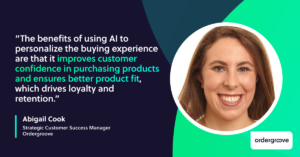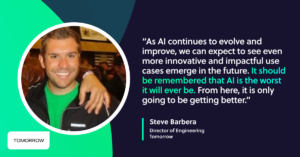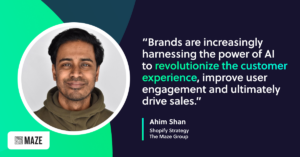Thought Leadership
Boost your bottom line: 4 real-world examples of how eCommerce brands are leveraging AI

Artificial intelligence (AI) has exploded onto the scene with the emergence of ChapGPT. But while AI is absolutely a powerful tool, it can be challenging to know how to implement it within your business. To help you get started, we asked four eCommerce experts to share real-world examples of how brands can use AI to boost their bottom line and stay ahead of the competition.
Ordergroove: Drive retention by analyzing your customer journey

While artificial intelligence is having a moment, the truth is that eCommerce brands have been using AI to drive results for years, and it’s easy to understand why. AI enables eCommerce brands to better understand their customers. In turn, they can use these insights to personalize their buying experience, which leads to improved acquisition and retention.
One of my favorite examples of a brand successfully using AI is La Roche-Posay, a popular skincare brand that’s recommended by 90,000 dermatologists worldwide. Earlier this year, La Roche-Posay launched MyRoutine AI, a tool that helps shoppers determine the right skincare regimen for their skin type. After a shopper uploads a picture, MyRoutine AI scans the photo and reveals the strengths and target areas of the user’s skin across seven key areas, such as aging signs and firmness. Afterward, the tool recommends a personalized skincare routine. The benefits of this type of buying experience are that it improves customer confidence in purchasing La Roche-Posay products and ensures better product fit, which drives loyalty and retention.
After being paired with the perfect product for their skin type, their customers can subscribe to have the item(s) automatically delivered on a routine basis. In some cases, repeat use of a product that’s personalized to the individual’s specific needs makes them more efficacious, leading to better results, happier customers, and higher lifetime value. Subscriptions ensure customers never run out of a product, bolstering their ability to maintain their regime.
– Abigail Cook, Strategic Customer Success Manager, Ordergroove
Tomorrow: Streamline data-driven decisions

Artificial intelligence has already become an indispensable tool for many businesses looking to improve their customer experience. With its ability to process vast amounts of data and provide insights in real time, AI can help brands make data-driven decisions and streamline their processes. Here are some real-world examples of how brands are using AI to enhance their customer experience:
Personalized customer support: AI-powered chatbots are being used by businesses to provide 24/7 customer support. These chatbots can handle simple queries, such as checking the status of an order, and escalate more complex issues to human agents. The chatbots can also be trained to understand the context of the conversation, making the customer experience more personalized.
Automation of product descriptions and product image creation: AI can help businesses automate the process of creating product descriptions and images. For example, AI can be trained to recognize the features of a product and generate a detailed description based on that information. Similarly, AI can be used to create high-quality product images, eliminating the need for manual product photography.
More fluent search and suggestions for products: AI can be used to improve the search functionality of eCommerce websites, making it easier for customers to find what they are looking for. AI can also be used to provide personalized product recommendations based on a customer’s purchase history and browsing behavior.
In conclusion, AI has the potential to revolutionize the customer experience and help businesses become more agile and efficient. As AI continues to evolve and improve, we can expect to see even more innovative and impactful use cases emerge in the future. It should be remembered that AI is the worst it will ever be. From here, it is only going to be getting better.
– Steve Barbera, Director of Engineering, Tomorrow
Corra: Create more content to boost SEO

There are many types of AI already broadly in use in the eCommerce world. For example, AI-powered product recommendations, which we have many clients using to great benefit through partners of ours like Dynamic Yield. While not as sexy or newsworthy as generative AI, we have seen it prove beneficial to our clients’ AOV and revenue metrics time and time again.
In terms of generative AI, we are seeing our clients utilize tools like ChatGPT to create more content at a faster pace, primarily for SEO purposes. We believe the bar for “meaningful content” is only going to continue to go higher and higher with Google’s algorithm updates last year and now the use of generative AI tools, making it easier for brands to create that content.
That said, we anticipate that as consumer usage of generative AI grows, it will have a dramatic impact on all upper funnel marketing. As more product discovery and browse behavior happens in AI spaces, we anticipate a decrease in direct upper funnel traffic to owned properties. This means two things: eCommerce businesses need to invest heavily in ensuring their content and products are meaningful and relevant so that they are picked up when a consumer types in “Please curate a shopping list for me.” Secondly, it will mean that when that traffic does hit a site, it will be lower funnel, qualified traffic, and the business better be certain their checkout flow is completely optimized to capture it. We are still in the very early stages of understanding how these changes in consumer behavior are going to revolutionize the traditional eCommerce funnel.
– Duke Marr, SVP Strategy and Marketing, Corra
The Maze Group: Boost cross-sells and upsells

Brands are increasingly harnessing the power of AI to revolutionize the customer experience, improve user engagement and ultimately drive sales. Large Language Models (LLMs), the secret sauce behind generative AI, are being successfully integrated into various aspects of the business to improve internal operations and output. Where we want to focus today is cross-selling/upselling.
Algorithms can analyze a customer’s purchase history and browsing behavior to suggest complementary products and/or higher alternatives. This personalization is being done at a one-to-one level through the AI. This has shown impressive increases in the average order value (AOV) and overall shopping experience for customers.
Consumers expect brands to go beyond the “frequently purchased with” model. Brands must drive upsells via individualized value adds. The customers that can provide a truly customized offer (offers are NOT exclusively discounts) at either checkout or in an email see a significant uptick in cross-sells and/or upsells.
Predicting this kind of behavior is even more important to our subscription-based clients. With the commoditization of consumer goods, the customer experience is at the forefront. Brands that can deliver value beyond the product see a considerable reduction in churn.
By implementing AI solutions, brands can not only stay ahead of their competitors but also adapt to the rapidly changing expectations and demands of today’s consumers.
– Ahim Shan, Shopify Strategy, The Maze Group
Each month, Ordergroove asks experts to share their opinions on eCommerce, Relationship Commerce, or subscriptions. If you have a question for our experts or want to be considered for inclusion in future blog posts, email us at hi@ordergroove.com.